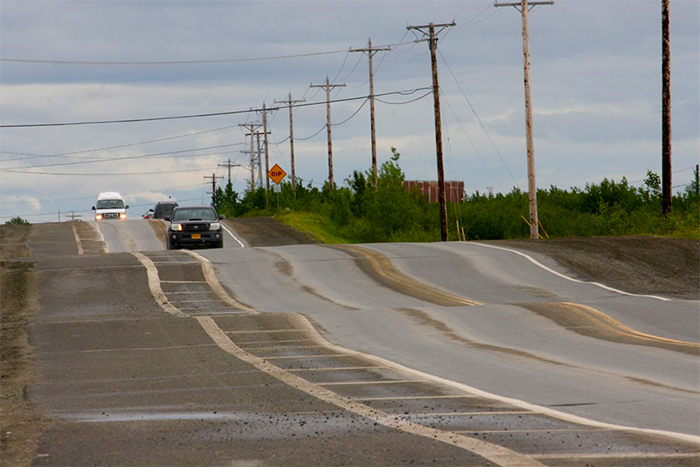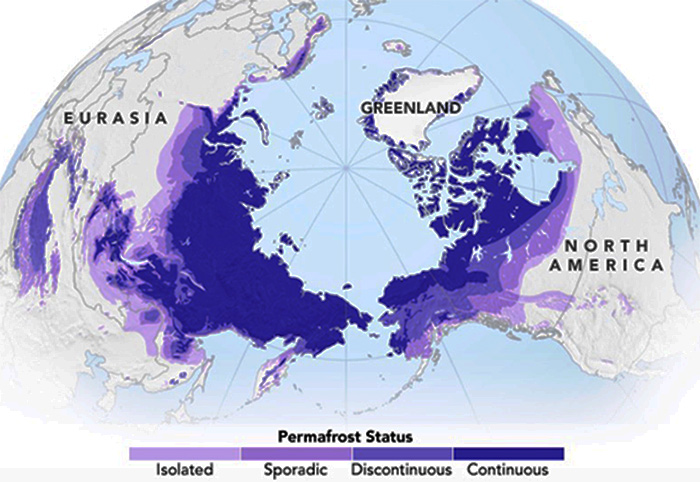
Credit: Lisa Demer, with permission from Anchorage Daily News
Since 2000, the Arctic has warmed more than other areas, up to 5°F. And that’s beginning to melt the permafrost.
In the Arctic winter, the earth is frozen, from tens to thousands of feet down.
In summer, the top several feet melt, creating a so-called active layer where plants can take root.
Below that is permafrost: frozen soil that contains a great deal of ice. For these regions, it’s like bedrock—stabilizing the active layer and providing a solid footing for buildings.
But as the melting reaches deeper into the ground, the permafrost is not so permanent and is becoming unstable. Roads in Alaska and Canada are beginning to undulate and ripple, and runways are at risk. Foundations are shifting, making some buildings and houses unusable. Surface water drains and floods unpredictably.
What widespread effects could this have?
Permafrost, like regular soil, contains organic material from dead plants and animals.
As it melts, the organic matter decays, releasing CO2 and methane, both greenhouse gases. This could create a feedback loop of continued greenhouse gas release and further warming.
But melting permafrost is also creating a deeper soil layer, which may allow forests to replace tundra. In other places, it’s toppling existing forests and replacing them with wetlands. These would absorb CO2.
With permafrost covering nearly a quarter of the Northern Hemisphere, scientists are keeping a close eye on these changes and how they impact climate models.
Background
- Permafrost is melting with rising Arctic temperatures and changing how people must interact with nature.
- Permafrost is soil or sediment that remains frozen for 2 or more consecutive years.
- Permafrost, which forms when the average air temperature is 28°F or colder, extends from tens to hundreds of feet into the earth; permafrost as thick as 4,900 ft has been measured in Siberia.
- Like regular soil, it contains huge amounts of organic material from decaying plants and animals—but these organics have been frozen and their biological activity is in suspended animation.
- It may also contain ancient methane frozen into hydrates—ice that burns.
- Earth’s permafrost is believed to contain twice as much carbon as exists in our present-day global atmosphere.
- The Arctic is warming twice as fast as the rest of the planet.
- On the surface and even as deep as 65 ft into the ground, temperatures have warmed by up to 5°F since the turn of the century. The Arctic could lose 30–70% of its permafrost in the next century.
- As the carbon-based organic matter in the permafrost thaws, the matter is consumed by microorganisms like bacteria and fungi, which release carbon dioxide in the presence of oxygen, or methane when oxygen is scarce underwater.
- As temperatures warm, more permafrost melts, perpetuating and intensifying the effects. We will talk more about this process in a future EarthDate episode.
- Thawing of permafrost is a gradual process.
- Permafrost typically contains 20% ice in its upper layers; it is very strong, and can easily support roads and buildings.
- The ground is fully frozen in winter. When spring comes, warmer temperatures cause the ground to thaw from the top down, creating the “active layer,” which historically has ranged from 1 to 12 ft thick. Plant life can only grow in this layer, and only when the soil has thawed.
- Permafrost is typically covered by tundra vegetation such as lichens, heath, and moss. Where this blanketing insulation is absent, permafrost is more vulnerable to thawing.
- Winter warming seems to limit refreezing of the permafrost and has been shown to have a larger impact than summer warming on long-term thawing.
- As permafrost thaws to deeper and deeper levels, it changes the landscape for the thousands of people who live on frozen soils across Canada, Alaska, and Siberia.
- With so much water locked up as ice in permafrost, the active layer is very wet and weak; it often thaws unevenly, creating boggy depressions and slumping of the land surface.
- Wet regions may dry out, and dry regions may flood as the distribution of liquid water changes in the ecosystem.
- Perched Arctic lakes may change level as their previously frozen banks leak, connecting them to changing water tables in the melting permafrost.
- As the ground undulates, power poles and trees jut out of the ground at odd angles, and riverbanks erode in new places.
- When ice wedges within the frozen ground thaw, roads and buildings shift as the ground subsides and falls into voids formerly supported by ice.
- In some areas, buildings require foundation re-leveling every year as the unpredictable ground surface shifts seasonally, causing doors to stick, walls to crack, and plumbing pipes to break or fail to drain properly. Some buildings even have to be abandoned completely.
- Buildings were originally built on snowshoe-like structures of posts that rested on wooden pads. After that, wooden pilings were used, but today, most of these have been replaced by hollow steel pilings filled with gravel slurry.
- Just 30 years ago, when the deepest permafrost was around 12–18 ft deep, builders set their pilings at about 18 ft. But now, in some towns, builders must drill 24–36 ft deep to find the top of the frozen ground, and longer pilings must be installed in both new construction and older buildings.
- In one case, a hospital had to be built with heat-extracting probes to keep the ground below its wings frozen. Otherwise the three-story building would have needed 110-ft pilings.
- Experiments are underway to test whether vented, hollow air-filled pilings or screw-shaped pilings might less perturb the permafrost.
- In some cases, roads, airport runways, and parking lots are built on foundations of liquid-filled piping that refrigerate the ground to prevent thawing—an attempt to keep the surface flat through engineering.
- Buried water and sewer lines, as well as highway culverts, can cause linear depressions on the surface as they thaw the permafrost, so engineers have to figure out how to keep them cold.
- Even the dead can’t rest in peace. As cemeteries thaw, gravesites flood where the permafrost has been disturbed, so some towns are now burying their dead in mausoleums above the permafrost.


